Karnataka has been above the national average in indicators of income, human development governance and many others. But it does shine better, if a road map is given as a quality reference document. What are the gaps that could gear up human development, improve literacy and education, change health care delivery systems, transform the social status of the deprived castes, and change gender equations? These and many more issues are addressed in the Karnataka Development Report by 80 subject specialists, coordinated by 20 experts from five research institutions—four from Bangalore, Indian Institute of Management, National Institute of Advanced Studies, Institution of Agricultural Technology, Institute for Social and Economic Change, and one from Dharwad, the Centre for Multi Disciplinary Development Research. The Planning Commission commissioned ISEC which provided the expertise and coordinated the work.
The Karnataka Development Report with eighteen chapters on development issues in four parts focusses on macro perspectives and sectoral growths, microeconomic and social issues, governance, transparency and accountability and policy drive.

